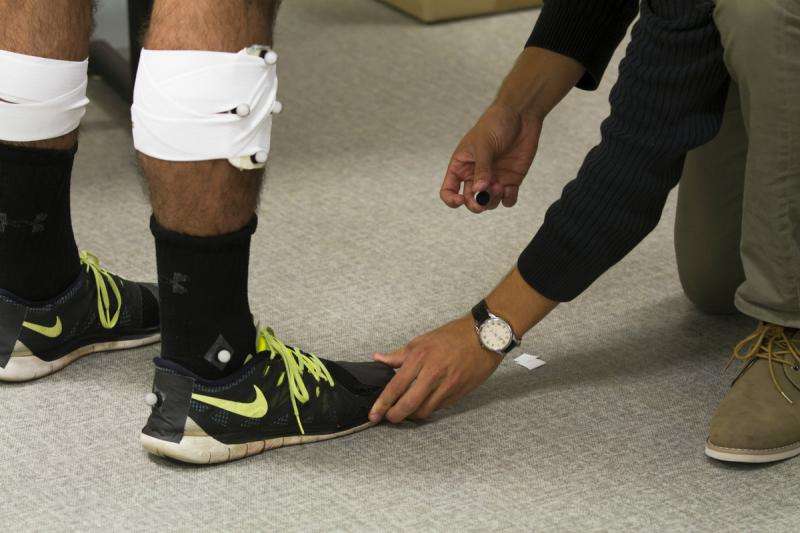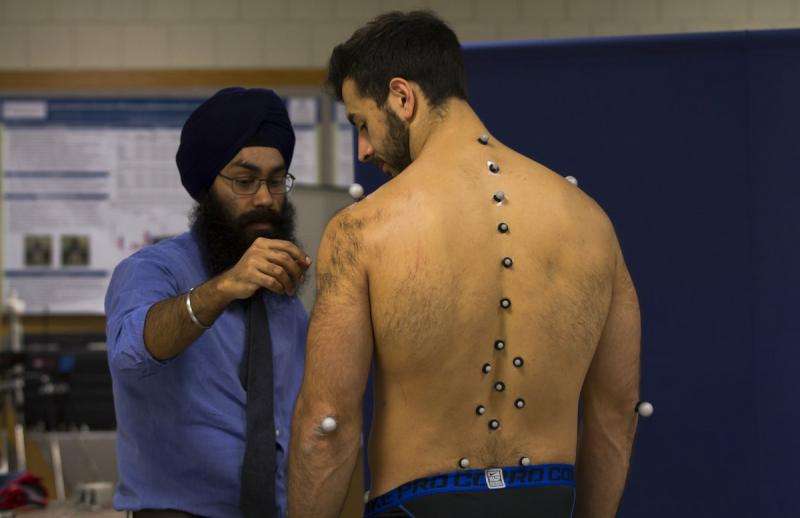Spherical markers are affixed to a participant in the running study. Credit: Giovanni Santacroce
Who says you can't stay physically fit well into your old age? A new study from Ithaca College biomechanics researcher Rumit Singh Kakar reveals that running mechanics remain largely unchanged as runners grow older.
Kakar—an assistant professor of physical therapy—and his research partner, University of Georgia Professor Kathy Simpson, presented the initial findings of their ongoing study at the American College of Sports Medicine National Conference in May 2016.
"As we progress from a young age to middle age, we can essentially maintain our running form," said Kakar, who teaches in the college's School of Health Science and Human Performance. "That means we should be able to compete or run as efficiently."
The study examines the spinal movement of runners in three different age groups: young adults (18-30 years old), middle-aged adults (30-50 years old) and old-aged adults (50 years and older). So far, the results indicate that there is little change in running form between young and middle-aged runners. Kakar needs more participants aged 50 and older before he can draw conclusions about the old-aged group.
"There's this common belief that as you grow older you can't do certain movements or that you should avoid doing high intensity exercise like running due to age-related changes—such as degradation of the joints," said Kakar. "But skills gained by running consistently matter more than age itself for healthy individuals."
Credit: Ithaca College
In addition to learning how age affects spinal movement in runners, the study will also help reveal the ideal spine mechanics demonstrated during running. So far, Kakar says his study has shown that runners' spines generally move less side-to-side and front-to-back as they run faster. Instead, they rotate more at higher speeds.
"We know ideal running form for lower extremities, but we don't yet know ideal running mechanics for the spine," said Kakar.
The study is taking place in the Movement Analysis Lab at Ithaca College. Participants are asked to run at three different paces—a slow, moderate and sub-maximal speed—while wearing reflective markers. Using the equipment in the state-of-the-art lab, Kakar and his student assistants capture changes in the runners' form at different speeds.
Physical therapy students Natalie Knight and Zachary Finer are assisting Kakar with virtually all aspects of the study, from interviewing potential participants to analyzing data collected in the lab. Working in the lab gives students the opportunity to put into practice the theory they learn in the classroom.
"A lot of the concepts that we learned end up being applied to what we're looking at in the lab," said Finer, who completed his undergraduate degree last year and is now a doctoral student.
Assistant Professor Rumit Singh Kakar places markers on a study participant. Credit: Giovanni Santacroce
A junior, Knight began working in the Movement Analysis Lab during her freshman year. She says her experiences in the lab introduced her to the sort of professional work she may do after finishing her degree.
"As a freshman, it was cool to really see what my future entails," said Knight.
About 50 runners have participated in the study so far. Kakar says he hopes to get to 75, and specifically needs more runners in the oldest age bracket.
If you are interested in participating in the study, email Natalie Knight at nknight@ithaca.edu.
Provided by Ithaca College






















